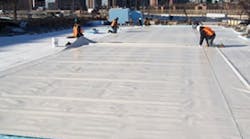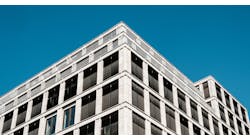It seems like all roofing manufacturers are now touting the lowest life cycle cost. How do I determine what product really does have the lowest life cycle cost for my building in my environment?
What components make up the calculation of the costs over the life cycle of the roof? How do I calculate a life cycle cost comparison between two different roofing systems? For the answers to these questions, read on.
A Life Cycle Cost Comparison: Our example
For purposes of this paper, we will compare a premium black roof, which requires asphalt as the adhesive and includes a white granular surface vs. a premium fully adhered white membrane roof. The 10,000 square foot roof will be installed in Columbus, Ohio. This is a reroof project, which currently has a three-ply built-up roof system. We will also assume the structure weight limitation is close to its maximum. We will use the time period of 20 years to determine the life cycle cost, given that 20 years is the minimum timeframe most building owners want their roof to last.
Sources of Information Used in This Paper
This article is advertiser sponsored:
We referred to a study conducted by the late Carl Cash of Simpson, Gumpertz and Heger, Inc., a leading and highly respected roofing consultant, for 80 percent of the cost assumptions we make in this paper. Cash’s study is probably the most extensive study of roof life and related life cycle costs ever to be completed in the industry. Two other leading roofing consultants and the U.S. Department of Energy (DOE) contributed most of the remaining 20 percent of our cost assumptions for this paper.
Summary of a 20-Year Life Cycle Cost Comparison
Before we examine the different variables that are typically used to calculate the life cycle cost of a roof, let’s take a look at the initial installed cost of our comparison example roofs in Columbus, Ohio. The initial cost of the premium black roof with the granular surface is $56,800 vs. $57,800 for the premium white membrane roof. Based on that cost alone, the decision seems to be almost a toss up - but is it?
The total life cycle cost over 20 years, not incorporating a Present Value analysis, tells a different story. Over 20 years, the premium black roof with a white granular surface will cost an estimated $115,220; the premium white membrane roof will cost $46,600. Though this may not sound logical, according to all of the sources used to calculate this cost, it is accurate.
Variables Used to Calculate Life Cycle Cost
Contrary to what most people think, the initial installed cost is not the dominate factor in the overall life cycle cost of a roof. The expected life of a given roof in a given environment has the most impact on the roof’s overall life cycle cost.
Why? If a roof doesn’t last the desired 20 years, the owner is likely to incur higher than average maintenance costs and, towards the end of the roof’s life, also major renovation costs; maybe even a total roof replacement.
In addition to initial installed costs, maintenance costs and major renovation costs, variables that factor into a life cycle cost calculation are (if relevant): disposal costs, the energy savings incurred by installing a lighter colored roof, and any State, City or Utility rebates offered for installing energy efficient roof systems.
Expected Roof Life
Our research sources indicate that the average life of the premium black roof in our example is 13.9 years; the average life of the premium white roof in our example is greater than 20 years.
The real life of a roof can vary greatly depending on the conditions in the roof’s local environment. Consider things like the following: Is your building located in the South where UV rays are more intense? Is your roof exposed to chemicals generated by processing food items or other manufactured products? Is the building near an airport where jet fuel can wreck havoc on the roof?
When performing your own life cycle cost analysis be sure to use numbers that represent the proven life of the selected product as it has performed in the same environment of your facility.
A Word on Warranties
Do not rely on the length of the product’s warranty as a prediction of its proven life. Why not? A 20-year, or even a 30-year “limited” warranty, doesn’t guarantee your roof will last 20 or 30 years. A limited warranty exists to protect the roofing manufacturer from liability; hence, the word “limited” is used. Many building owners, unfortunately, see “20 Years” on the top of the warranty document, and make the false assumption that the roof is guaranteed to last 20 years.
In handling warranty claims, the burden of proof lies with you. Even if the damages to your roof fall within the coverage of your warranty, remember you may have to factor in the cost of additional damages to the building caused by the damages on your roof and the cost of any lost production time.
Become familiar with the details of your warranty. Pay special attention to the exclusions it lists – most warranties have them. For example, most premium black roofs exclude ponding water. Other systems exclude winds above 39 mph, and still others exclude exposure to any type of chemicals.
Do your homework on the manufacturer and the product. Some roofing systems haven’t even existed for 20 years in any environment, yet manufacturers will offer a 30-year “limited” warranty. Other roof systems have been around by name for 15 years, but the manufacturer may have changed the chemical formula in the product multiple times. Other roofing systems may have a 20-year track record, but the manufacturer will not be able to show you an example of a 20-year installation in the same environment as your roof.
Remember, the number of years that you should use in calculating a life cycle cost, according to most experts, is the proven life of a given roof with the same chemical formula, in your environment. There is no substitute for this information. No lab tests can totally predict the life of a roof in the real world.
Initial installed cost
Black Roof: $56,800 ($5.68 per sq ft)
White Roof: $57,800 ($5.78 per sq ft)
In our example, the initial installed cost per square feet of the black roof includes $2.40 for material, which includes ¼” densdeck and 1.5” insulation, $1.29 labor, and 15% SG&A and 20% profit for the contractor. For the white roof, costs include $2.57 for material, which also includes ¼” densdeck and 1.5” insulation, $1.19 labor, and the 15% SG&A and 20% profit for the contractor. Note, the costs listed are reported national averages.
Energy Saved
Black Roof: $ 4,000 ( $ .02 per sq ft per year x 20 yrs)
White Roof: $16,000 ($ .08 per sq ft per year x 20 yrs)
Much has been written about energy savings with white roofs. The most comprehensive set of data available is from the United States Department of Energy (DOE). The DOE measures the energy savings of various roofing systems in 243 different U.S. cities. The DOE’s Web site allows viewers to calculate energy savings.
The DOE model starts with these three variables: geographic location, solar reflectance (SR) and infrared emittance (IE). (Infrared emittance is, in effect, the heat that is generated from the roofing material itself, i.e. a white membrane roof is much cooler to the touch compared to an uncoated metal roof.) We referred to the Cool Roof Rating Council (CRRC) for the solar reflectance and infrared emittance values that we use in our example. For the premium white membrane roof, the SR is 83 and IE is 85. Given that the black roof in our example has a white granular surface, the SR would be 31 and IE 88. (The higher the SR number the better, and conversely, the lower the IE number the better.)
Other variables in the DOE model include: R-value, summertime cost of electricity, air conditioner efficiency, natural gas cost, heating system efficiency and electricity demand charged during the cooling season. For purposes of our example in Columbus, we used average values for all of the variables in the DOE calculator.
These numbers will be misleading if you don’t follow the recommendations of the National Association of Roofing Contractors (NRCA) to clean a roof every three years. In addition, the amount of insulation in your roofing system can have an impact, as discussed in the next paragraph. Further, the exact location of your building impacts the numbers to use when calculating projected energy savings. Certainly geographic locations in the southern U.S. will have a much greater impact on the energy savings with a white roof. Surprisingly to most, all geographic locations studied by the DOE in the continental U.S. incur some sort of energy savings when a white roof is installed vs. a black roof, assuming average values to all of the variables in the model; i.e. average insulation.
The black roof heats in the winter and totally offsets the white roof cooling in the summer – a fallacy
Given “average” insulation, according to the DOE, in all Continental U.S. States, black roofs do help heat in the winter. That doesn’t, however, offset the cooling effect that white roofs have in the summer. Two things drive that; one, the sun in much hotter in the summer months; and, two, most northern States heat with natural gas and cool with electricity. Electricity is more expensive than natural gas.
If you have a “very high” amount of insulation for your region, an amount that typically is cost prohibitive, the energy savings from a white roof is insignificant in many regions.
Maintenance Costs
Premium black roof: $23,300
Premium white roof: $5,800
Both systems include semi-annual inspections, which is recommended by NRCA. In addition, the premium white roof includes a “cleaning” every three years to maximize the reflectivity index.
According to the leading consultants referenced earlier, the maintenance costs for these two systems would start off about the same. In approximately seven years, however, owners can expect costs for the black roof to accelerate due to the deterioration of the asphalt due to UV and other environmental variables.
Major Renovation Costs
Premium black roof: $29,157
Premium white roof: $ 0
Major renovation costs include costs incurred after the roof’s expected useful life is reached. In our example, the average life of the premium black roof is 13.9 years. Given we have set a 20 year goal for this calculation, on average, starting in year 15, the owner will have to either install a new roof or have the expense of major renovation work. We opted to take the conservative approach in this life cycle calculator; hence, this cost reflects the option of a major renovation. In an effort to estimate major renovation costs, the calculator takes the initial installed cost, plus 3% for inflation per year, and divides by the 13.9 expected life and places that amortized figure in years 15 to 20.
Disposal Costs
Premium black roof: $9,963
Premium white roof: $0
For purposes of this example, as we mentioned at the onset of this paper, we assumed that the structure weight of our building is near its maximum. Therefore, to illustrate the impact of disposal costs on the total life cycle cost, we’ve assumed that the current built-up roof would have to be removed if you installed our black roof example, but would not have to be removed with our white roof example. This is fairly common given the added weight of the black roof.
Note: the disposal cost figured above does not include the labor required to remove the current roof, only the cost of disposing the roof.
Summary
Below is a bar graph that illustrates the comparison between the different variables:
Click here and we’ll send you a life cycle cost calculator so you can determine a rough estimate of the life cycle cost of your present roof, or compare it to an alternative roofing system.
Contact Us:
For more information about FiberTite Roof Systems please call Seaman Corporation at 800-927-8578, extension 5953. Ask for Art Marangi.


